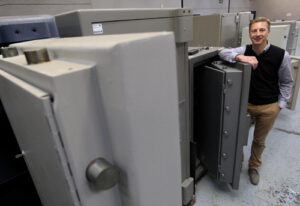 Think you know about safes? PSI caught up with Stephen Wylde of eSafes to find out what is happening in the world of safes and installation and why not carrying out a site survey or fitting the correct safe could be a costly mistake
Think you know about safes? PSI caught up with Stephen Wylde of eSafes to find out what is happening in the world of safes and installation and why not carrying out a site survey or fitting the correct safe could be a costly mistake
How have safes developed over the years?
Due to advances in manufacturing technology, and customer demands, safes have gotten a lot lighter. This means that installing, removing or simply moving a safe is easier. The designs that safe manufacturers are coming up with are a lot cleverer now. In the past a safe was just a metal box to store valuables in. Now, they can be built with bespoke designs for storing watches, jewellery, data and memory drives.
There are more locking options to choose from than ever before. In addition to traditional key and combination locks you can now get electronic, finger and palm scanning locks — and safe manufacturers haven’t just improved how you get into your safe, they’ve improved on what they keep out: with better fire and water damage protection.
Perhaps best of all, the past decade has seen new manufacturers enter the market place and provide more choices for the customer. This competition keeps safe innovation moving forward and gives customers a better range of choices. It’s a good time to be in the market for a home or office safe.
What are the essentials for safe installation?
The key first step is picking a location for your safe. Ideally, if you are building new premises you should plan around the safe. Usually, the safe is considered last when in reality it can be the most important part, especially for companies that need large safes which require a lot of room.
You’ll need to have a solid concrete floor or wall in which to set the safe, or a set of wooden joists to bolt the safe in place. A safe is only really as good as its placement allows it to be.
What are the common installer errors you see?
A big mistake that a lot of people make is installing a new safe in a poor location, which isn’t hidden away, simply because the installation process is then easier.
Some safe installation companies don’t actually carry out a site survey and simply turn up to a site blind. This leads to aborted safe installations, when a safe is too large or they don’t have the correct equipment to transport it into the correct place.
Using the wrong bolts is also another common mistake.
What are the security myths about safes?
A common myth about safes is that they can be picked or drilled open easily. Hollywood films, in particular, suggest that safes are easy to get into but with modern locking technology this isn’t the case. Also, burglars only spend 8 to 12 minutes on average within a house during a robbery. They haven’t got the time to spend on picking locks — and they’ll often just leave a safe altogether.
Another myth is that any safe will do. This isn’t true. You need to pick a safe with the correct cash or valuables rating for your contents. That way, if worst comes to worst, you will be insured for the right amount. If you place £20,000 cash in a safe that only has a cash rating of £10,000, you’re only going to get half of it back at best when you make a claim.
Finally, we have heard some people suggest that one method of locking is better than another but key, biometric, combination and electronic locks all have their strengths and in their own way provide high level security, so it would be wrong to suggest that a certain lock is better than another. It’s all about context; where the safe is going to be placed, who is going to require access to it, how often etc.
You mentioned insurance. What is the role of the insurer when it comes to safes and safe installation?
A number of eSafes customers are actually referred to us directly by their insurance companies. An insurer will advise customers of the level of cover that they need, depending on the security solutions they have in place. In some cases, the insurer can even recommend a specific model of safe for their needs.
The insurance industry is proactive in providing insurance ratings for safes with bodies like the Association of Insurance Surveyors (AiS).

